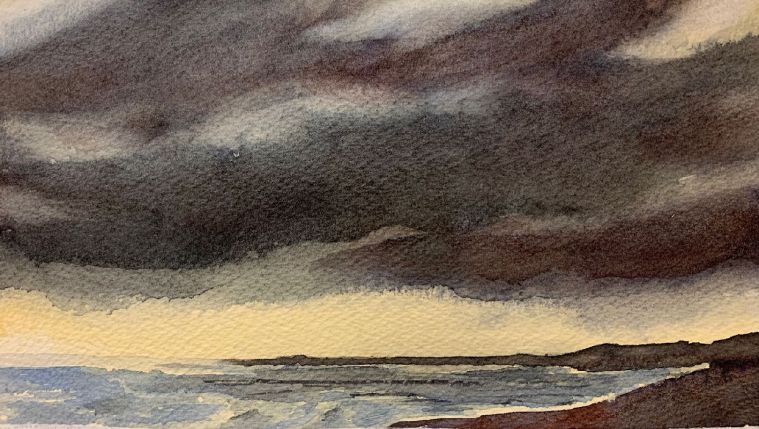Before I paint, do I really have to plan? It’ll spoil the mood. Can’t I just paint?
So many factors seem to be pushing an artist to just get started quickly on a painting. We may feel inspired, excited, or the colors in the sky may be changing fast, or the weather may be cold or threatening rain. While there’s no reason we can’t occasionally jump right into painting without preliminary thought, doing so will almost always make failure more likely.
Time spent in thoughtful preparation, on the other hand, is usually well spent. Planning ahead and thinking about your goals for the painting do NOT in any way stifle creativity! You will still evaluate your work as you go along, as well as react and adjust to what is happening on your paper. Only when you have clearly defined your objectives will you be able to exploit developments as they take place during the painting process.

Take the time to DESIGN your picture. Don’t jump the gun. Study your subject for a while before starting to paint. Think about what it is that attracted you – that should be the primary statement or BIG IDEA in your painting. Everything else should be subordinate.
Ask yourself what is your focal point? What is your painting about? Think about what you want to say before you start! WHAT do you hope to achieve and HOW are you going to achieve it? Without some clear objectives, you probably will have difficulty creating something extraordinary.

So, to create a better painting , consider what you will emphasize in the picture. Eliminate anything that might compete with or distract from the ONE focal point and main idea. You shouldn’t try to include every daunting detail in a scene. Instead, it pays to NARROW your vision and SIMPLIFY your subject.
The key to simplifying the image you’re painting is doing CAREFUL PLANNING as well as understanding GOOD COMPOSITION. See these blog posts for more information about composition. Read Designing A Strong Painting With Good Composition!, 10/16/2018, https://leemuirhaman.com/2018/10/16/designing-a-strong-painting/. Also, check out Simplify Your Watercolors By Focusing On Shapes!, 7/16/19, https://leemuirhaman.com/2019/07/16/simplify-your-watercolors-by-focusing-on-shapes/ .

Generally, good design includes foreground or a ‘lead-in’ to draw your viewer into the picture, a strong focus, and framing or supporting details. But sometimes surrounding details can be reduced, contrast around the center of interest can be increased, or features can be rearranged or eliminated completely to simplify and improve the picture. Cropping an image can be extremely helpful.
The SIMPLER your shapes, the more POWER your picture can have. It actually takes more effort to create a bold simple painting than to jump right into putting paint to paper, struggling to work out any problems as you go along.

Artist Bill Vrscak believes “the simplest statements mean the most.” He also says “A bold, simple statement respects the viewer’s intelligence. Do your viewers a favor: Don’t bore them with extraneous detail. Make your point and get out.” Further, he suggests LEAVING OUT tiny shapes that can cause confusion, large dark areas, insignificant details, and too much surface detail.
To improve you painting, forget about ‘reproducing’ nature. Start to REARRANGE it! Simplify to make your subject more interesting and effective than you found it.
I’ve got a newsletter now! Join me and get painting tips, inspiration, the latest news about classes, new art or products for sale. Subscribe here. I’ll give you a free copy of my Color Blending Tips pdf., that you can download and print.
Nice job, Lee.❤️❤️
LikeLiked by 1 person
Thanks – Really glad you liked it!
LikeLiked by 1 person